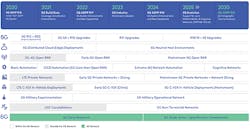It’s All About Network Assurance —
The network must be the focus if network service providers want to deliver on the promise of 5G. As we look at the road ahead for next-gen networks, 10 network-related trends illustrate why network assurance is behind 5G’s future success.
10 Network-Related Trends
Trend #1. Waves of Construction
The extensive transport network and field testing work we’ve been conducting tells us that operators will continue to spend and aggressively expand their coverage footprints. In some APAC countries, this work has already begun with hundreds of thousands of 5G base stations deployed, greatly exceeding initial targets. This work will continue for many years as tens of millions of base stations are commissioned globally.
Trend #2. Standalone 5G Networks
We will see continued acceleration toward Standalone (SA) 5G in North America and China. These networks will launch alongside Non Standalone (NSA) networks but until operators grow more comfortable managing and supporting the new core, we expect limited access of SA.
Globally, the cautious start for SA is not unlike the migration to a virtual Evolved Packet Core (vEPC) we witnessed as 4G matured. However, operators are quickly moving some traffic onto SA since 3GPP R15 standards were published. As of December 2020, more than 60 CSPs are investing in 5G Standalone (Source: GSA).
It’s up, up and away for 5G, but the network must be the focus if network service providers want to deliver on the promise of 5G.
Trend #3. Spectrum Demands
We won’t have a true picture of how the 5G market will shake out until the dust settles on the flurry of spectrum auctions taking place globally. Low-band, mid-band, high-band, c-band — you name it, it’s all in high demand. The volume of testing we’re seeing across multiple frequency ranges and validation of new RAN capabilities, like Dynamic Spectrum Sharing across a range of geographies, suggests high interest in spectrum auctions and availability to support geographic coverage.
Notably, the private industry is eager to carve out a piece of its own 5G spectrum, with national regulators beginning to dedicate spectrum exclusively for this purpose. 4G LTE will remain mainstream for private networks in 2021, but enhanced trials of 5G and early adoption by leading innovators is anticipated, with mmWave tech in APAC likely to see commercial deployments in late 2021. This provides a glimpse of 5G’s expanded potential as enterprise adoption drives new revenue opportunities.
Trend #4. Open Networking
Open RAN shows its potential to become telecom’s low-cost, vendor-neutral future. It can serve as an efficient architecture for, and is, the foundation of novel Network-as-a-Service plays.
All use cases are on the table as more and more muscle is put behind this effort. This initiative will grow unabated as testing focuses on interoperability, performance, and operational costs.
But first, expect to see a focus on legacy network densification for rural coverage with 5G Open RAN deployments still being years off. The market for Open RAN solutions is expected to grow to more than $11B by 2026. (Source: Appledore Research)
Trend #5. Advancing Automation
Operators got an unexpected taste of automation’s power during 2020, and they’re hooked. Network service providers demonstrated there was no task that automation couldn’t handle effectively and efficiently — from the lab to the field.
We anticipate Tier One operators will focus on vendor-neutral, continuous testing environments that provide an automated CI/CD pipeline process to manage multi-vendor ecosystems and continuous releases. Expect this to eventually become the norm for agile management of developing initiatives, like Open RAN.
Operators will continue to spend and aggressively expand their coverage footprints.
Trend #6. Edgy Models
If there’s one thing everyone can agree on, it’s that the combination of lower latency, reduced backhaul, and security, promised by edge computing are worth the pursuit.
How to get there? That’s another matter entirely as experimentation and a search for killer use cases continues.
The cloud hyperscalers want in on this potentially game-changing tech that could position mobile operators to deliver incredible next-gen app experiences. Cloud companies can bring developers into the fold, and seamlessly hand off sessions to the telco edge, while mobile and cable operators have access to subscribers, location, billing profiles, and more. A joint effort makes sense, helping ease the associated complexity and cost burdens for both players.
Ultimately, operators will need thousands upon thousands of edge locations across national footprints over the next 3 years. A hybrid model that combines a range of technical and business approaches will be required, however. With this in mind, it will be a priority to figure how to test and assure hybrid infrastructures consisting of self-build, hyperscaler-hosted, and neutral host environments, from new entrants.
Trend #7. Fixed Wireless Access (FWA)
As more businesses adopt permanent (work from home) WFH policies over the next decade, 5G FWA will see a surge in demand on the back of robust, ubiquitous, and secure 5G coverage.
Look for FWA to ultimately power unprecedented remote work environments that demand automation, augmented reality, and telepresence. We expect to continue to see FWA business case exploration, meaningful test work, and growth milestones, in North America and Western Europe.
And don’t underestimate the significance of Wi-Fi 6 (and Wi-Fi 6E), which also stands to play a major role in in-home connectivity.
Trend #8. Defense and Commercial Tech
4G LTE wasn’t quite robust enough for a serious look from defense departments with mission critical demands. Not so with 5G, where investment is pouring in as governments scrutinize capabilities in support of future defense modernization.
Because 5G could be as flexible and evolutionary as the challenge of emerging threats themselves, it has the potential to power rapid responses in a range of situations and environments, transforming the way the military operates, and enabling a new generation of the knowledge economy.
The U.S. Department of Defense is one of the most advanced in its investments, committing hundreds of millions of dollars toward 5G experimentation across AR/VR for mission planning and training, smart warehousing, distributed command and control, and dynamic spectrum utilization. In fact, the US DoD has announced $600 million in awards for 5G experimentation (Source: US DoD).
Trend #9. Driving With 5G
More auto manufacturers are planning the future integration of 5G chipsets into vehicles. This speaks to anticipation of national coverage over the next three to four years and confidence that connectivity will be robust enough to support emergency and maintenance features. China, especially, is seeing acceleration toward 5G connected vehicles for a range of use cases, with preparation for commercial availability by major car manufacturers as soon as early 2022.
5G digital twins are also playing a starring role in some global automotive testing efforts, replicating complex 5G networks in lifelike lab environments. These efforts are helping to expedite millions of hours of testing that would otherwise require stakeholders to jump through a series of network and transportation authority hoops in the real world.
By 2022, General Motors plans to launch vehicles capable of 5G connectivity for Chinese consumers (Source: GM).
Trend #10. 6G Daydreams
When you’re in the thick of it, daydreaming about the future is inevitable. Such is the case for a vocal cohort already looking to 6G to solve some of 5G’s initial shortcomings. But it’s far too early to count 5G out — not with so many features and capabilities set to be added over the next decade as up to 4 more 3GPP industry standards releases introduce even more functionality.
Putting too much stock in 6G now, while it remains about a decade away, risks 5G becoming politicized. Plus, 5G is directionally well understood today while 6G could eventually take an entirely different direction by the time we actually get there. Focusing on 5G’s ability to deliver capacity and coverage while accelerating innovation is Spirent’s near-term focus in its work with customers.
From-the-Field Perspectives
Operators won’t be able to monetize investments with value-added applications unless the infrastructure works. The industry is currently grappling with the nitty gritty details to help the 5G infrastructure perform as it should. This means certifying and deploying equipment and software at scale and at speed.
InvisiLight® Solution for Deploying Fiber
April 2, 2022Go to Market Faster. Speed up Network Deployment
April 2, 2022Episode 10: Fiber Optic Closure Specs Explained…
April 1, 2022Food for Thought from Our 2022 ICT Visionaries
April 1, 2022Key Developments
With that in mind, we anticipate the following key developments throughout the remainder of 2021.
Testing amid rapid obsolescence.
As we move toward a more containerized world, new solution set releases are being introduced every month and going out-of-support every 2 to 3 months.
It is no longer a question of testing releases in the lab for a year or more. Testing will need to move to near real time. Therefore, we will see more automated lab-to-live testing, which takes lab testing capabilities into live run time environments, to support this paradigm shift.
Pre-integrating agents into hardware.
Beyond the traditional network vendors, cloud assurance agents are starting to be pre-integrated into OEM equipment. By using SaaS to unlock the agents, it will be much faster and easier to continuously certify and troubleshoot all layers of the live network.
This also opens a window to using the same approach with large enterprise production networks that face similar CI/CD change management challenges.
Transport timing and synchronization challenges.
One of the biggest challenges for 5G networks with disparate access mechanisms is network timing for mmWave.
Another question is how 5G network slicing will work.
Building out the network.
As the SA network gets deployed and early 5G private networks are stood up, there will be new challenges in connecting and deploying the edge and core. This includes certifying all layers, assuring edge latency, and making sure that accurate and deterministic network timing and synchronization work throughout. For Private Networks and operator B2B engagements, the integration of Time Sensitive Networking (TSN) will be critical for 5G networks to deliver reliable, low latency connectivity across time-critical Industrial IoT applications.
These trends and field realities mean that finding the right partner is key. We are partnering with Tier One operators to deliver outcomes that meet larger service delivery business goals across the entire lifecycle. This end-to-end consultative approach is poised to result in faster deployments that free operators to focus on other critical elements of service design and delivery.
Resources and Notes
For more information, see 5G 2021: Market Drivers, Insights And Considerations. A Spirent Report. https://assets.ctfassets.net/wcxs9ap8i19s/6EJaFo7HX4EfHASgqMnot3/ed1026864f4a031e3001b4b39f7fe254/Spirent-5G-Report-2021.pdf
https://appledoreresearch.com/2020/12/14/open-ran-market-research-report/
https://www.cnbc.com/2020/08/19/gm-to-launch-5g-connected-vehicles-in-china-starting-in-2022.html
https://gsacom.com/technology/5g/
For more information, please contact https://www.spirent.com/contact or visit https://www.spirent.com. Follow Stephen on Twitter @s_n_douglas and Spirent @Spirent.












